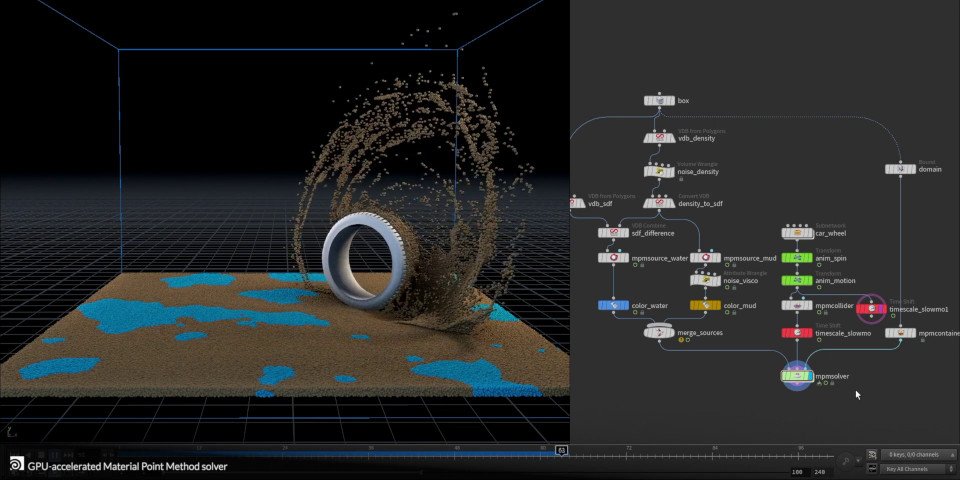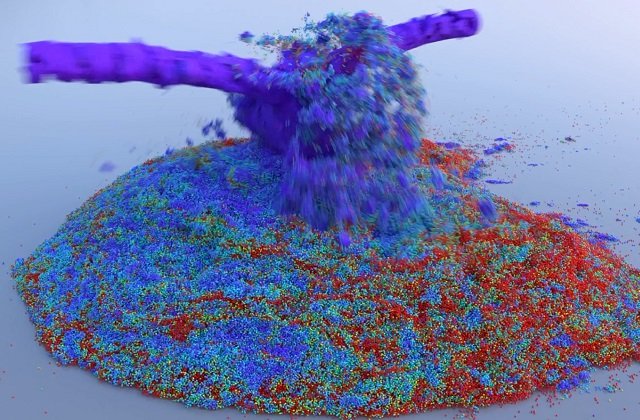In the world of visual effects (VFX), simulation technology has rapidly evolved, allowing for more realistic and immersive scenes in films, games, and virtual experiences. One of the standout advancements in recent years is the Material Point Method (MPM) Solver introduced in Houdini 20.5, which has revolutionized how snow and sand are simulated. By 2030, this technology has significantly impacted the industry, offering artists unprecedented control and realism when working with complex materials.
In this article, we will explore the industry impact of the MPM Solver in Houdini, highlight the benefits of this technology, and examine three success stories that showcase its real-world applications in the VFX industry.

How the MPM Solver Transforms the VFX Industry
Houdini’s MPM Solver specializes in simulating granular materials such as snow, sand, mud, and soil, allowing these materials to interact with rigid and soft bodies in a highly realistic way. The industry impact of this technology is profound because it fills a longstanding gap in the VFX world—accurately simulating how granular materials behave under stress, deformation, and movement.
By 2030, the MPM Solver has become a cornerstone for studios working on large-scale productions that require dynamic and detailed simulations. Whether it’s a snow avalanche cascading down a mountainside, or sand swirling in the wind of a desert storm, the MPM Solver enables artists to achieve complex and lifelike effects that were previously difficult or time-consuming to simulate.

The Benefits of the MPM Solver in VFX Production
The benefits of the MPM Solver in the VFX industry are multifold, driving efficiency, realism, and creativity in production pipelines. Below are some of the key advantages:
- Increased Realism: The MPM Solver mimics real-world physics, ensuring that materials like snow and sand behave in a physically accurate way. For example, snow compacts, breaks apart, and flows naturally based on environmental factors, creating lifelike results that immerse audiences in the experience.
- Streamlined Workflow: In the past, simulating granular materials required multiple solvers and post-processing to make them interact with other elements. With Houdini 20.5’s MPM Solver, this process is now unified, reducing production time and simplifying artist workflows.
- Creative Flexibility: The MPM Solver gives artists more control over how snow and sand react to forces, enabling them to create everything from delicate wind-blown sand particles to massive snow avalanches with a few adjustments. This level of customization opens the door to greater creative exploration in VFX production.

Three Success Stories of the MPM Solver in Action
The MPM Solver’s real-world applications have been successfully implemented across various industries, proving its versatility and effectiveness. Here are three success stories that demonstrate the impact of the MPM Solver on VFX projects.
1. Success Story 1: Film Production – “Blizzard’s Wrath”
One of the most notable success stories showcasing Houdini’s MPM Solver comes from the 2028 feature film “Blizzard’s Wrath.” In this epic survival drama, the VFX team was tasked with creating a massive snowstorm and avalanche sequence that spanned several minutes of screen time.
The challenge was to realistically simulate snow buildup, compaction, and the devastating impact of the avalanche as it tore through a small mountain village. The team turned to Houdini 20.5’s MPM Solver to simulate every snowflake’s interaction with the environment, from light falling snow to the heavy, crushing weight of the avalanche.
Previously, these effects would have required separate solvers and countless hours of manual tweaking. The MPM Solver’s ability to seamlessly simulate granular snow interacting with buildings, vehicles, and characters allowed the team to reduce production time by 30% while achieving a level of realism that stunned audiences. The innovative use of the MPM Solver was praised as one of the film’s standout technical achievements, earning accolades for its photorealistic avalanche effects.
2. Success Story 2: Game Development – “Desert Siege”
The gaming industry has also greatly benefited from the MPM Solver in Houdini. One particularly exciting example is the open-world adventure game “Desert Siege”, released in 2029. The game is set in a vast desert, and players must navigate a shifting landscape of sand dunes, dust storms, and collapsing ruins.
The development team used the MPM Solver to create highly detailed sand simulations that reacted dynamically to the player’s actions. As players moved through the desert, the sand would shift, blow, and collapse, creating a fully immersive experience. Unlike previous game titles that relied on baked-in effects for sand, Desert Siege featured real-time sand deformation and particle interaction, all thanks to Houdini’s MPM Solver.
The industry impact of this technology in gaming cannot be overstated. Desert Siege became known for its unparalleled realism, and the game’s developers attributed much of this success to the MPM Solver’s ability to simulate sand in a dynamic and lifelike manner. The innovative use of this technology in game development has since inspired other studios to incorporate granular material simulations into their games, particularly for environments like deserts, beaches, and battlefields.
3. Success Story 3: VR and Theme Park Entertainment – “Sands of Time”
The MPM Solver has also found success in virtual reality (VR) experiences and theme park attractions. One standout example is the immersive VR experience “Sands of Time,” which debuted at a major theme park in 2030. This interactive experience places visitors in the middle of a raging sandstorm, where they must navigate through ancient ruins while sand whirls around them and shifts under their feet.
Houdini’s MPM Solver was used to simulate the complex interaction between sand and the ruins, as well as the players themselves. As visitors moved through the environment, the sand would respond dynamically to their footsteps, creating a sense of realism that added to the overall immersion. The simulation even allowed for real-time environmental changes as sand accumulated and buried objects over time.
The success of Sands of Time demonstrated the MPM Solver’s potential in real-world applications, particularly in entertainment and interactive experiences. Its ability to simulate sand in a realistic way helped bring the virtual environment to life, creating a thrilling and unforgettable experience for park-goers.
The Future of Houdini’s MPM Solver
By 2030, Houdini’s MPM Solver has solidified itself as an essential tool for VFX artists, game developers, and entertainment designers. The ability to simulate realistic snow, sand, and other granular materials has allowed studios to create more engaging, visually stunning content. The innovative use of the MPM Solver has unlocked new creative possibilities, reducing production costs while improving realism and immersion.
Looking ahead, the MPM Solver is expected to continue evolving, offering even more advanced simulation techniques and real-time capabilities. As the demand for interactive and immersive experiences grows, the role of Houdini’s MPM Solver will only become more critical in meeting industry needs.

Overall
Houdini 20.5’s MPM Solver has revolutionized the simulation of snow, sand, and other granular materials across various industries. From the jaw-dropping snowstorm in “Blizzard’s Wrath”, to the dynamic sand simulations in “Desert Siege”, and the fully immersive VR experience of “Sands of Time”, this technology has transformed how studios approach simulation.
The benefits of the MPM Solver are clear: increased realism, streamlined workflows, and endless creative possibilities. As we look to the future, it’s evident that the MPM Solver will continue to shape the industry, offering new ways to create immersive and lifelike environments.
With years of expertise in this technology, we are here to support your needs. If you’re interested in learning more about similar technologies and how they can be applied, feel free to reach out to our team. You can also connect with us via LinkedIn or reach our support team on WhatsApp.






